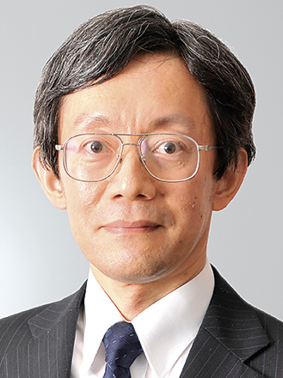GLOBAL INNOVATION REPORT
Contributions to ISO Technical Committee 224

There has been considerable activity on international standardization over recent years in the field of water and the environment. One such body, the International Organization for Standardization (ISO), hosts technical committees (TCs) on topics such as water quality, water and sewage services, water reuse, and sludge treatment that are actively engaged in the development of standards for their respective fields.
ISO/TC 224 is the committee that deals with water and sewage services. Proposed by France and established in 2001, the committee has been in operation for more than 20 years. Japan has been involved from the very beginning, with participation coordinated across the public and private sectors, and Hitachi, Ltd. contributing to activities in Japan as well as serving as an international committee member.
This article looks back at the activities of ISO/TC 224 from the perspective of the author who served on the committee for 10 years from 2012, also giving examples of how Japan has contributed and reporting on the latest developments.
In ISO/International Electrotechnical Commission (IEC) Guide 2, the ISO defines a standard as a “document, established by consensus and approved by a recognized body, that provides, for common and repeated use, rules, guidelines or characteristics for activities or their results, aimed at the achievement of the optimum degree of order in a given context.” International standards are needed so that products and technologies can be traded across borders and be used as intended. Parts such as batteries or screws are typical examples of standardized products. In recent times, however, the scope of standardization has expanded beyond materials and products to also encompass the evaluation and management of business processes and services.
The benefits of international standards include the manufacturing of products with consistent quality at low cost and the facilitation of management and services. Moreover, the Technical Barriers to Trade (TBT) agreement of the World Trade Organization (WTO) stipulates that participating nations formulate their domestic standards on the basis of international standards. This means that, even in their domestic economies, nations need to pay attention to what is happening with international standardization.
The ISO, the International Electrotechnical Commission (IEC), and the International Telecommunication Union (ITU) are among the main bodies engaged in developing international standards. In particular, ISO has responsibility for international standards outside the fields of electric power and electronics and has over a 160 member nations. The Japanese Industrial Standards Committee (JISC) serves as the ISO member for Japan.
Meanwhile, international standardization is not left out when it comes to working toward the Sustainable Development Goals (SDGs) of the United Nations. For example, ISO has published data on the number of its standards that are directly applicable to each of the 17 SDGs(1) (see Figure 1).
Figure 1 | Number of ISO standards Directly Applicable to 17 SDGs (as of August 31, 2022) In recent years, the International Organization for Standardization (ISO) has publicized its contribution to the SDGs by listing the number of its standards that are directly applicable to each of the 17 goals.
In recent years, the International Organization for Standardization (ISO) has publicized its contribution to the SDGs by listing the number of its standards that are directly applicable to each of the 17 goals.
The goal with the highest number of applicable standards (13,346) is also the one that relates to the provision of resilient water infrastructure, namely Goal 9 (Build resilient infrastructure, promote inclusive and sustainable industrialization and foster innovation). Next highest is Goal 3 (Ensure healthy lives and promote well-being for all at all ages) with 3,150 applicable standards. This goal includes action on disease caused by waterborne infections and poor water quality. Other goals that relate to water are Goal 6 (Ensure availability and sustainable management of water and sanitation for all) with 618 applicable standards, and Goal 14 (Conserve and sustainably use the oceans, seas and marine resources for sustainable development) with 320 applicable standards (as of August 31, 2022).
Table 1 | Main ISO Technical Committees Dealing with Water (as of August 31, 2022)(3) Numerous ISO committees are engaged in work on international standardization in the water industry.
Numerous ISO committees are engaged in work on international standardization in the water industry.
International standardization goes beyond the formulation of product standards for things like measurement techniques or product dimensions and materials. In recent years, its scope has expanded to include service standards that take a user standpoint and the standardization of societal systems. In response to these changes, data and services were among a number of additions made to the scope of standards in Japan and elsewhere, with the Japanese Industrial Standards (JIS) being revised in July 2019 (2).
The scope of international standardization has also expanded in the fields of water and the environment, extending beyond product standards to include standards for services and those that address the resolution of societal challenges. Table 1 lists the main ISO TCs relevant to this area(3).
With regard to service standards, ISO/TC 224 was established in 2001 and has been actively working on standardization that considers the users of water and sewage services. This is covered in more detail below.
Similarly, ISO/TC 282 addresses the resolution of societal challenges, contributing to the protection of the environment by working on international standards for water reuse. In relation to the reuse of sewage or industrial wastewater, Japan participated in the formulation of ISO 20468, which provides guidelines on the performance evaluation of treatment technologies for water reuse systems. The Ministry of Land, Infrastructure, Transport and Tourism (MLIT) is looking to leverage the publication of this international standard to boost the overseas adoption of Japanese water treatment technologies(4).
ISO/TC 147 has 50 years of history behind it, and its ongoing work on the international standardization of water quality has included the approval in August 2021 of a new draft standard proposed by Germany for the detection of SARS-CoV-2 in wastewater(5).
All of these can be seen as instances where standardization is relevant not only to product manufacturers and service providers, but also to service users and to the resolution of societal challenges.
Table 2 | ISO/TC 224 Working Groups and International Standards Formulated (as of August 31, 2022) A total of 22 international standards have been published, with a large number of further standards currently under development.
A total of 22 international standards have been published, with a large number of further standards currently under development.
ISO/TC 224, the technical committee on “Service activities relating to drinking water supply systems and wastewater systems,” was established in 2001 at the proposal of France. Service assessment guidelines for the providers and users of drinking water and wastewater services (ISO 24510, 24511, 24512) were published in 2007. These standards laid out the underlying principles behind the performance indicators (PIs) used for the quantitative assessment of these services and have been adopted in national standards as guidelines for setting PIs. The assessment indicators used for Japan’s water and sewage services were also referenced in the standards.
Specifically, by entering a variety of operational data into the mathematical formulae that define the PIs, they enable quantitative comparisons to be made against past performance or with the service level or facilities of other providers. Note, however, that the guidelines also advise on the need, when making such comparisons, to take due account of contextual considerations such as cultural factors and the natural environment in which the service operates.
These three guidelines are currently subject to regular reviews, with Japan among the participants in this work.
Since 2008, ISO/TC 224 has also been working on standards that address specific issues such as asset management, crisis management, smart water management, and climate change adaptation. Table 2 lists the standards that are under preparation or already published by ISO/TC 224 working groups (as of August 31, 2022).
Note that the TC scopes are not fixed, changing over time. The scope of ISO/TC 224 was changed in 2017 to “Service activities relating to drinking water supply, wastewater, and stormwater systems” to clearly indicate its interest in stormwater. This was further extended in 2021 to “Drinking water, wastewater, and stormwater systems and services” so as to cover the design, specification, and construction of associated products and systems as well as the services themselves.
Japan has its own committees in the form of the Japan Sewage Works Association and the Japan Water Works Association and these organizations delegate people to serve as Japan’s representatives at the ISO/TC 224 working groups. These people are drawn not only from Japan’s water and sewage utilities and associated institutions, but also from private-sector companies, with delegates being sent by the Federation of Japan Water Industries, Inc. This has also included Hitachi, with a delegate serving on Working Group (WG) 7 (Crisis management of water utilities) since 2012.
This section describes recent activities undertaken by ISO/TC 224.
Figure 2 | Sequence, Overlap, and Intensity of Activities during the Phases of a Crisis The figure shows the main concepts involved in the organizational response to a crisis.
The figure shows the main concepts involved in the organizational response to a crisis.
Water and sewage services are at risk of a wide variety of emergencies, including natural disasters, plant failures, and human errors or accidents. Established at the behest of a proposal from Israel, WG 7 has developed, over the more than 10 years of its existence, a variety of international standards relating to how water and sewage utilities respond to sudden crises. During this time, Japan has reported on the extent of damage to water and sewage infrastructure caused by the Great East Japan Earthquake of March 2011, hosting a meeting of the working group at Sendai in October 2013 where members from other nations were able to view first-hand the level of damage to water and sewage treatment plants.
WG 7 published guidelines for the crisis management of water utilities (ISO 24518) in 2015 and a collection of case studies (ISO 24520) in 2017. These standards collate guidance on the management of each stage of a crisis, covering how to prepare, how to respond at an organizational level when a crisis occurs, and the subsequent steps from recovery to the restoration of normal operations. Figure 2 shows the main concepts.
In 2019, meanwhile, WG 9, which deals with related matters, published a technical specification (TS) on the event detection process (ISO/TS 24522) that covers the early detection of anomalies in water and wastewater utilities based on a variety of measurements and reports. Based on a proposal from Hitachi, Japan presented case studies to WG 9 that included a system for detecting upstream water quality problems to facilitate halting downstream intake by water supply systems and a system for the early detection of heavy rainfall events that helps sewage systems avoid stormwater inflows. These were published as examples of good practices.
WG 7 has gone on to publish new standards, including guidelines on providing alternative drinking water services during a crisis (ISO 24527) and guidelines for continuous monitoring of water quality in drinking water distribution networks (ISO/TS 24541). Japan supplied a local case study to ISO 24527 at the request of the committee chair (Israel) and drafted part of the text of ISO 24541 in partnership with the member from Morocco.
During this time, Japan has maintained good relations with the other committee members, including the holding of discussions with water supply experts from Germany and Canada, and receiving advice from the USA and UK members on the wording of the English language text, succeeding in having case studies contributed by Japan and Hitachi reflected in the international standard.
ISO/TC 224 has also been engaged in international standardization that relates to environmental protection. Work on an international standard for the efficient use of water got underway in 2015 in response to a proposal from Singapore. This contains requirements and guidelines for efficient water management systems that water-using organizations can use to plan and implement water-saving measures. The standard was published in 2019 as ISO 46001.
Meanwhile, countries around the world are experiencing many damaging heavy rainfall events, with climate change being one factor. In 2015, Japan’s MLIT partnered with sewage utilities and other interested organizations to establish WG 11 to work on standards for stormwater management. As a result of this initiative, guidelines for flood control that focused on the planning and design stages (ISO 24536) were published in 2019 and a technical report with examples of good practices for stormwater management (ISO/TR 24539) was issued in 2021.
Taking this work further, a working group to address climate change adaptation (WG 16) got underway in 2020. Work has already commenced on formulating guidelines for adapting water services to climate change impacts (ISO 24566), starting with work on developing assessment principles.
Figure 3 | Japanese Members Attending Online Plenary Meeting of ISO/TC 224 These Japanese members attended the 2022 plenary meeting of ISO/TC 224 online (on June 24 at the Japan Water Works Association).
These Japanese members attended the 2022 plenary meeting of ISO/TC 224 online (on June 24 at the Japan Water Works Association).
This article has covered some of the past and present work on international standardization in the field of water and the environment, especially that of ISO/TC 224.
With international standardization, what tends to catch people’s attention is the rivalry between nations and the bargaining conducted by business. However, the Japanese members of ISO/TC 224 have gone in as experts, with the expectation of presenting advanced technologies and best practices. Rather than adopting an attitude of only pursuing the interests of their own country or company, they recognize the need to cooperate with the other national delegates to create standards that will help to improve water and sewage services and the associated natural environments.
More than 20 years have passed since ISO/TC 224 was established and it continues to work actively, with more than 20 international standards published to date. ISO standards do not list the names of the committee members or nations involved in their drafting. Rather, the process is memorable for being one in which members from many different nations worked together and put years of time and effort into their development. Figure 3 shows some of the Japanese committee members attending the 2022 plenary meeting of ISO/TC 224, which was held online. Attending via screens, the meeting brought together a large number of members from across all six continents.
Hitachi intends to continue contributing to the resolution of the world’s water and environmental problems, working with relevant institutions in Japan and cooperating with the delegates from other nations in its ongoing involvement in the international standardization of water and sewage services.